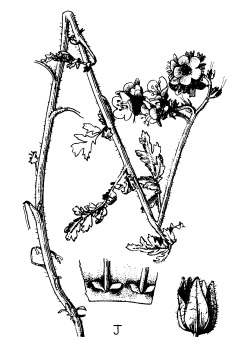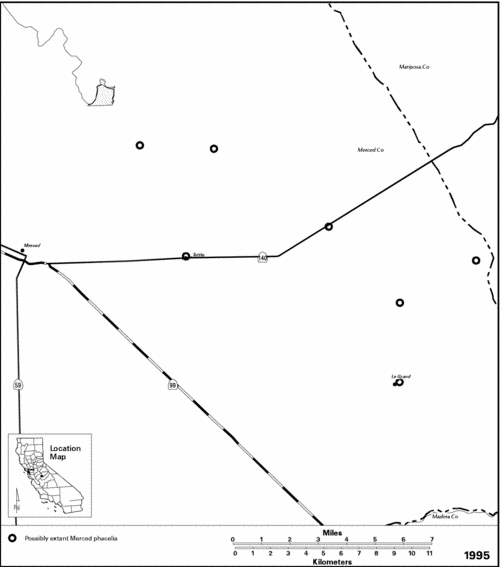Endangered Species Recovery Program | |
|
Home | News | Publications | Species profiles | Data and maps | About | Staff | Links | Department of Biological Sciences | CSU Stanislaus |
Recovery Plan for Upland Species of the San Joaquin Valley, California
Contents
. Introduction
. Species accounts
. Recovery
. Stepdown
. Implementation
. References
. Appendix
12. Merced Phacelia (Phacelia ciliata var. opaca)
- Taxonomy
- Description
- Historical and Current Distribution
- Life History and Habitat
- Reasons for Decline and Threats to Survival
- Conservation Efforts
- Conservation Strategy
Taxonomy.-- Howell (1936) published the name Phacelia ciliata var. opaca for Merced phacelia. He cited the type locality as "clay hills 5 miles northeast of Merced, Merced Co." (Howell 1936, p. 221). Authors of subsequent floras (Abrams 1951, Munz and Keck 1959, Wilken et al. 1993) considered Merced phacelia to be merely a minor variant of the Chinese-lantern phacelia (P. ciliata) that did not warrant formal taxonomic recognition. Nonetheless, California Native Plant Society (Skinner and Pavlik 1994) continues to treat Merced phacelia as a distinct variety. This taxon is a member of the waterleaf family (Hydrophyllaceae).
Description.-- Merced phacelia (Figure 34) reaches a maximum height of 55 centimeters (22 inches). The leaves vary in both size and shape, ranging from 3 to 15 centimeters (1 to 6 inches) long and from deeply-lobed to divided. Each branch tip is coiled like a scorpions tail and holds many flowers. The individual flowers are approximately 1 centimeter (0.5 inch) long, bell-shaped, and blue with pale centers. The calyx, which is the group of leaf-like structures below the petals, has five ciliate (with stiff hairs along the margin) lobes (free tips of parts that are fused at the base). The calyx is inconspicuous while the flowers are open; as the fruits mature, the calyx lobes elongate and become opaque (hence variety opaca). Conversely, in Chinese-lantern phacelia the calyx lobes grow broader and remain translucent at maturity (Wilken et al. 1993, Constance 1979).

Figure 34. Illustration of Merced phacelia.
Historical and Current Distribution.-- Merced phacelia was collected in east-central Merced County near the towns of Le Grand, Merced, Planada, and Tuttle between 1929 and 1939 (Figure 35). A very small population, consisting of fewer than 10 individuals, was observed in 1977 approximately 10 kilometers (6 miles) northeast of Merced. The other historical locations have not been visited for over 50 years due to a lack of access (Howell 1936, Skinner and Pavlik 1994, CDFG 1995, Constance 1979).

Figure 35. Distribution of Merced phacelia (Phacelia ciliata var. opaca).
Life History and Habitat.--This annual plant flowers between February and May. Merced phacelia is restricted to heavy clay soils on the Valley floor and adjacent low hills at eleations below 100 meters (328 feet). Other aspects of its life history and habitat have not been reported (Howell 1936, Hoover 1937, Skinner and Pavlik 1994, Constance 1979).
Reasons for Decline and Threats to Survival.-- Merced phacelia is rare by virtue of its restricted range. Most historic populations are inaccessible, therefore, no estimate can be given of the species relative abundance. The historical sites do not face any known threats at this time, though development of the planned University of California campus east of Merced and the consequent induced growth should be considered a significant threat.
Conservation Efforts.-- No conservation measures have been instituted for Merced phacelia.
Conservation Strategy.-- Cooperation of property owners will be key to protecting this taxon. To ensure the long-term conservation of Merced phacelia, the strategy is to protect at least five distinct populations. Protected areas should be natural land in blocks of at least 65 hectares (160 acres) and should contain a minimum of 1,000 individuals to reduce the likelihood of extinction from intrinsic or random processes. The first step will be for qualified botanists to obtain permission to survey historical locations to determine the current status of populations. Prospects for the persistence of Merced phacelia will be favorable if the majority of the populations remain extant and are free from threats. The second step, should any occupied habitats be found to face major threats, will be to pursue conservation easements, and identify and address site-specific management needs. Research into the taxonomy and genetics of the Phacelia ciliata complex could determine whether this taxon deserves recognition (Skinner et al. 1995), but it is a low-priority task. When surveys have been completed, or at a maximum within 10 years of recovery plan approval, the status of Merced phacelia should be reevaluated.